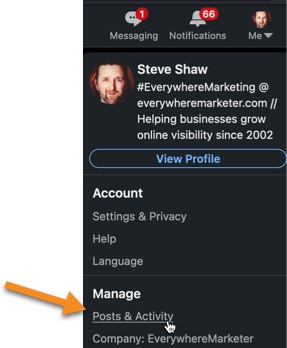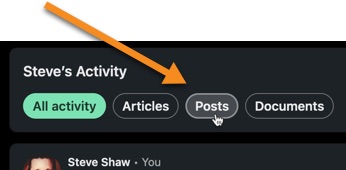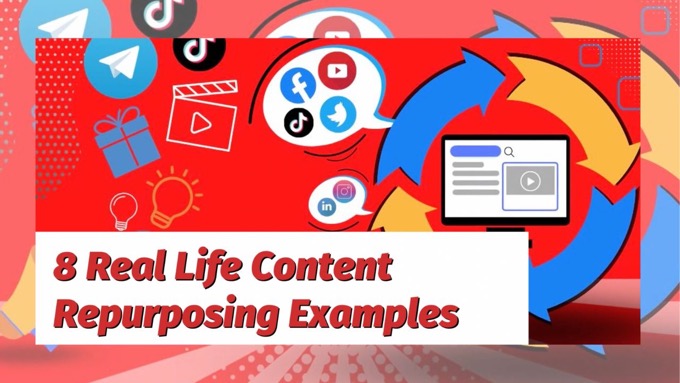With all the different advice about how often you should post on LinkedIn, what’s the truth?
That's what you're about to find out.
In this post, we look at:
- What the optimal posting levels are, based on the evidence
- The key question to ask that determines how often you should be posting
- With consistency so important, the best way to ensure you're posting consistently onto the platform.
But first…
Look at Your Current Engagement Level
How much visibility and engagement are you currently getting with your posts on LinkedIn?
As we’ll discuss shortly, this helps inform how often you should be posting on LinkedIn.
For a company page, check by clicking the View analytics link beneath a number of different posts.

There’s also a similar link under posts for your personal profile.

Find these by clicking through to Posts & Activity from your profile picture.

To just see your posts, click through on Posts.

So How Does This Affect How Often You Should Post on LinkedIn?
Here’s how LinkedIn’s algorithm works.
It looks at the amount of engagement your content attracts, and uses that to determine how widely to spread your content on the platform.
So if you’re not attracting that much engagement, it judges the value of what you’re sharing with your network to be relatively low, and reduces its visibility accordingly.
On the other hand, if you have healthy engagement levels showing the people in your network are enjoying and finding value in your content, it will extend the reach of your content so that more people see it.
If you're posting on LinkedIn frequently but not getting much engagement, slow down. It's better to focus on creating stronger content that attracts higher engagement.Click To Post OnWhat Does That Mean For How Often to Post?
In brief, if you’re posting frequently but getting little or no engagement, with every post you make, you’re simply reinforcing the impression LinkedIn has about your content.
In other words, you’re digging a deeper hole that can be hard to climb out of.
So if you find yourself in that position, it’s better to just slow down and focus on:
- Creating content that attracts more engagement
- Growing your network with the type of people likely to be interested in (and therefore, be more likely to engage in) the type of content you create.
After all, let’s be frank—no one’s seeing your content anyway, so there’s little point continuing with a relatively high level of frequency!
Once you see your engagement levels rise and you get the hang of what resonates best with your network, start to ramp the frequency back up.
With that in mind, the following recommendations assume that you’re already achieving a reasonable level of engagement for your content on LinkedIn.
Personal LinkedIn Profile
In general, people on LinkedIn like to engage with other human beings so they know who they’re communicating with.
This means it can be a lot more challenging to attract engagement through your company page than via a personal profile.
So for a personality-led business, such as solopreneurs, coaches, consultants, and businesses that have a personality brand at its head, you’re likely to see a better return on your time by focusing primarily on your personal profile rather than your company page.
As your influence grows, then sure, branch out, and start to focus additional attention on your company page.
So For Your Personal Profile, How Often Should You Be Posting?
The most important question to ask yourself is this…

Think about it.
After all, there’s little point in posting multiple times a day only to burn out after a couple of weeks and then only turn up sporadically.
Create a system that works for you and your team that allows you to show up consistently.
How often should you post to your personal profile on LinkedIn? As often as you can do so on a regular, sustainable and consistent basis.Click To Post OnAt a minimum, that should be a few times a week, but once a day if possible in order to:
- Simply get into the habit of posting...
- Keep showing up.
One of the most common obstacles people run into that stops them from doing this is simply knowing what to post.
That problem is largely solved when you’re already posting long-form content on a regular basis elsewhere, such as:
- A blog
- A podcast
- A YouTube channel
This type of content can be then splintered into all kinds of content suitable for posting to social media, including LinkedIn.
What’s more, with a proper process, other people can take care of virtually all of it so it’s not falling on you as the business owner.
The Secret to Showing Up Consistently Is This..
Doing as little as possible yourself!
Systematize everything so other people in your business are taking care of it.
Want an example?
Well, 80% of businesses use a blog as a marketing tool, so let’s see how it would work if you have one too…
Each of your blog posts can be adapted into different social media posts for LinkedIn (and of course, elsewhere).
These involve using different parts of the blog post and different types of media.
The result is multiple different social media posts created from your original blog posts that can then be shared at intervals for weeks or even months after your blog post was published.
Here are some examples of the types of social media post that can be created:
- A short face-to-camera video focusing on a particular aspect of the blog post
- A quote from the post alongside some text where you provide some helpful information based on content in the blog post

- Short “curiosity snippets” taken from the post that make people want to click through
- A video meme post using part of the post converted into audio
- A text motion post using some text from the post converted into an animated text video

- A straight-forward link post using the title and the post’s featured image (the image is pulled in automatically when have the social meta tags set up correctly on your blog)
You don’t have to try and cover every different type of post at once. But think about one or two additional social posts you can start to weave into the mix, and then expand from there.
Then simply figure out:
- What’s needed to create the new type of post
- Who’s going to do it
From there, develop a process that happens each and every time you publish a new blog post.
That’s how you get the all-important consistency you need!
The secret to showing up consistently on LinkedIn and other social media channels is this—do as little as possible yourself. Develop processes and systematize everything.Click To Post OnAnd the result is a developing stream of different types of content you now have available to post.
However, trying to manage the process manually will naturally be a headache. To get consistency, you need everything to be streamlined so it just happens.
That’s what the Trafficonomy software (specifically designed to help with organic content marketing) is designed to do, and is exactly what I use at EverywhereMarketer.
It means I can just focus on the blog posts, while the whole process of creating different types of post and sharing them on LinkedIn (and elsewhere) is taken care of for me.
LinkedIn Company Page
Of course, that all applies to company page updates too.
But are there any different guidelines for posting to your company page?
Again, regular, consistent activity is vital.
LinkedIn itself recommends that companies post one or more times every day as the most effective way to attract and engage followers.
Hootsuite recommends the same, while recommending posting no more than five times a day max.
They also make the benefits of consistent posting clear:
- Companies that post at least once a month gain followers 6x faster than those that post less frequently…
- Posting more frequently has additional benefits, with companies who post weekly seeing their engagement grow at twice the rate.
So ideally, you should be aiming at once a day minimum.
Remember, we live in an attention economy. To get the attention of your customer and attract leads for your business, you’ve simply got to keep showing up.
We all now live in an attention economy. To get the attention of your customer, consistency is key—you've got to keep showing up.Click To Post OnFrequently Asked Questions
How does LinkedIn's algorithm determine the visibility of your posts?
LinkedIn's algorithm looks at the engagement levels to decide how widely to distribute your content on the platform.
How often should I post to my personal profile on LinkedIn?
Post as frequently as you can consistently and sustainably, aiming for at least a few times a week or once a day.
What is the recommended posting frequency for a LinkedIn company page?
LinkedIn recommends posting once or more every day, with the ideal frequency being at least once a day to engage followers effectively.
What's the secret to consistent posting on LinkedIn?
The secret is to systematize tasks and delegate as much as possible to ensure regular content creation and sharing.
Why is consistency important in posting on LinkedIn?
Consistency is crucial in an attention economy to attract followers, engagement, and ultimately leads for your business.
To Conclude
As we’ve seen, regular, consistent posting to LinkedIn is the most important factor, rather than any set number of posts per week or day, and there is software available that streamlines the process and helps you achieve that.
Having said that, once a day at minimum is generally recommended so that you keep showing up in customer feeds and stay front of mind.
If you’re not there yet, push up the frequency by looking at where you’re regularly publishing content already, such as on a blog, and repurposing that content into different types of post that can then be shared on LinkedIn.
To ensure consistency, do as little as possible personally, but create processes in your business that other people are responsible and accountable for.



